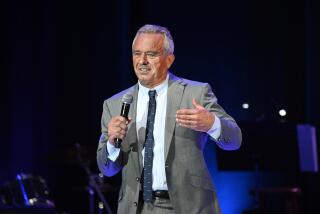Study Finds No Data Linking A-Tests, Deaths
- Share via
WASHINGTON — The most sweeping study so far of military participants in atmospheric nuclear tests uncovered two isolated groups of increased cancer deaths but found “no consistent evidence” overall that veterans of the tests suffer abnormal death rates from cancer or other diseases, it was reported Monday.
The study, by the federally funded National Research Council, confirmed earlier reports that military witnesses to a single 1957 atom bomb explosion have suffered an abnormally high death rate from leukemia. It also turned up an excess of prostate cancer deaths among participants in a 1956 series of explosions.
The prostate cancers appear to be a statistical fluke, however, and scientists “cannot convincingly either affirm or deny” that the leukemia deaths are bomb-related, the study stated.
‘Some Confidence’
“I think we can say with some confidence” that among most participants in the tests, “there is no evidence of any significant increased risk of cancer,” said Seymour Jablon, one of the report’s three authors. The same appears true as to other major causes of death studied, including coronary disease, cirrhosis, senility and instances of suicide, he added.
Two groups concerned with so-called “atomic veterans” reacted skeptically, contending that the study is statistically flawed and ignores growing reports of genetic defects and other medical problems among test participants.
One of the groups, the 5,000-member National Assn. of Atomic Veterans, dismissed the study as “garbage,” and the Missouri-based group’s director, Gloria Christopher, said: “I think they did the best they could do working for the government.”
She and others also said that servicemen are healthier than the general population and would be expected to suffer fewer early deaths from cancer and other common diseases.
The council’s report, by far the most comprehensive study of atomic veterans, examined about 5,000 persons who have died since taking part in a series of above-ground nuclear tests during the 1950s. The death reports were culled from the records of 46,000 of the 49,000 veterans known to have participated.
The five series of atomic tests studied by the panel include two rounds at the military’s Nevada Test Site and three at Bikini and Enewetak atolls in the South Pacific. (Enewetak’s name was changed from Eniwetok at the request of inhabitants who returned to the atoll in 1980.) Many participants are believed to have been exposed to higher-than-usual fallout levels during the tests studied, the study states.
1957 Nevada Test
The 1,046 cancer deaths among the group were 84% of what would have been expected in a similar-sized population drawn from the nation as a whole, the study reported. An unusual number of cancer deaths was found in two instances: among the 3,741 witnesses to a 1957 blast in the Nevada desert, dubbed “Smoky,” and among 10,202 witnesses to a series of 17 Pacific Ocean explosions with the code name “Redwing.”
Confirming a 1980 study by the federal Centers for Disease Control, the research council found 10 leukemia deaths among the “Smoky” participants, 2.5 times the deaths that would be normally expected.
However, the study noted, radiation-monitoring badges worn by some participants in the “Smoky” tests did not record unusually high levels of exposure, and scientists have found no other excess cancer deaths among witnesses to “Smoky” or the 19 other atomic tests of which “Smoky” was a part.
‘Chance Aberration’
The report concludes that the excess leukemia death rate “either was a chance aberration” or that actual radiation doses from the explosion were several times those recorded by the badges worn by participants.
Among participants in the “Redwing” series of 17 nuclear explosions, the 16 genital cancer deaths were roughly twice those expected in the general population, the study reported. Most were cancer of the prostate.
Jablon said the deaths probably are “a chance event.” Prostate cancer is not linked to doses of radiation.
Donald Boardman, a retired Massachusetts doctor who is president of the Center for Atomic Radiation Survivors, said the council should have gauged the atomic veterans’ deaths against those of 5,000 military men who had not been exposed to radiation.
“To compare vets to the national average is comparing apples and oranges, really,” he said.
Cites Time Lag
But Jablon said differences between veterans and the average population--particularly their susceptibility to cancer--”tend to diminish over time” and that the 15- to 20-year lag between the atomic tests and the council’s study is long enough to lessen their significance.
A spokesman for Rep. J. Roy Rowland (D-Ga.) said Rowland, a non-practicing physician and a member of the House Veterans Affairs Committee, likely will ask the congressional Office of Technology Assessment to review the methodology of the research council’s study.
In 1983, the technology office rejected as scientifically unsound a research council study that found no unusual rate of cancer deaths among U.S. troops who occupied the Hiroshima and Nagasaki atom bomb sites at the end of World War II.
More to Read
Sign up for Essential California
The most important California stories and recommendations in your inbox every morning.
You may occasionally receive promotional content from the Los Angeles Times.













